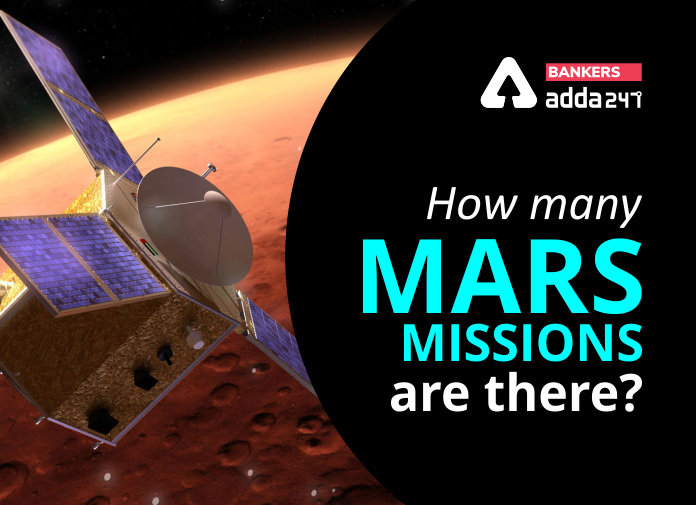The exploration of Mars Planet by humans is not new. While maneuvered missions have remained financial and logistical near-impossibilities, unmanned missions started in 1960. Mars has historically been unneighborly to Earth’s attempts to visit it. Mars is also called the Red Planet. Many missions have attempted to Mars in search of life and other things, but half of the attempts have failed, But since 1996, Mars exploration has undergone a revival with data from four orbiters and four landed missions evolving a new view of Mars as an Earth-like world with a complex geologic history.There have been 56 Mars missions so far, out of which 26 have successful. Recently China has successfully launched its first interplanetary mission Tianwen-1 to Mars on 23 July, the spacecraft will reach Mars in February 2021. when the spacecraft reaches Mars China could become just the second country to land and possess a rover on the Martian surface. This Mission has three Spacecrafts, These Spacecraft will work to study the geology of Mars and learn more about what might be hiding underneath the planet’s surface.
currently operational missions on Mars are one lander (InSight) and one rover (Curiosity) with another rover (Perseverance) due to launch this year. It doesn’t end there. Many more missions planned for the 2022 and 2024 launch windows, and there are proposals to put humans on Mars by the 2030s. Know all about the total numbers of Mars Mission and other details in this article.
List of Successful Mars Mission
| Space Craft | Country | Carrier Rocket | Launch Date | Remarks | Mission |
| Mariner 4 | United States (NASA) | Atlas LV-3 Agena-D | 28 Nov 1964 | The first flyby of Mars on 15 July 1965 | Flyby |
| Mariner 6 | United States (NASA) | Atlas SLV-3C Centaur-D | 25 Feb 1969 | Second Flyby of Mars | Flyby |
| Mariner 7 | United States (NASA) | Atlas SLV-3C Centaur-D | 27 March 1969 | Third Flyby of Mars | Flyby |
| Mars 2 | Soviet Union | Proton-K/D | 19 May 1971 | Entered orbit on 27 November 1971, operated for 362 orbits | Orbiter |
| Mars 3 | Soviet Union | Proton-K/D | 28 May 1971 | Entered orbit on 2 December 1971, operated for 20 orbits | Orbiter |
| Mars 3 lander | Soviet Union | Proton-K/D | 28 May 1971 | The first lander on Mars, soft landed on 2 December 1971. The first partial image (70 lines) was transmitted. | Lander |
| Mariner 9 | United States (NASA) | Atlas SLV-3C Centaur-D | 30 May 1971 | The first orbiter of Mars. Entered orbit on 14 November 1971 | Orbiter |
| Viking 1 orbiter | United States (NASA) | Titan IIIE Centaur-D1T | 20 August 1975 | Operated for 1385 orbits. Entered Mars orbit in 1976 June 19. | Orbiter |
| Viking 1 lander | United States (NASA) | Titan IIIE Centaur-D1T | 20 August 1975 | The second lander successfully returning data, deployed from Viking 1 orbiter. Operated for 2245 sols. Landed on Mars in 1976 July 20. | Lander |
| Viking 2 orbiter | United States (NASA) | Titan IIIE Centaur-D1T | 9 Sep 1975 | Operated for 700 orbits. Entered Mars orbit in 1976 August 7. | Orbiter |
| Viking 2 lander |
United States (NASA) | Titan IIIE Centaur-D1T | 9 Sep 1975 | Deployed from Viking 2 orbiter, operated for 1281 sols (11 Apr 1980). Landed on Mars in 1976 September 3. | Lander |
| Mars Global Surveyor | United States (NASA) | Delta II 7925 | 7 Nov 1996 | Operated for seven years | Orbiter |
| Mars Pathfinder | United States (NASA) | Delta II 7925 | 4 Dec 1996 | Landed at 19.13°N 33.22°W on 4 July 1997 | Lander |
| Sojourner | United States (NASA) | Delta II 7925 | 4 Dec 1996 | The first rover on another planet, operated for 84 days | Rover |
| Spirit (MER-A) |
United States (NASA) | Delta II 7925 | 10 June 2003 | Landed on January 4, 2004. Operated for 2208 sols |
Rover |
| Opportunity | United States (NASA) | Delta II 7925H | 8 July 2003 | Landed on January 25, 2004. Operated for 5351 sols |
Rover |
| Rosetta | European Union (ESA) | Ariane 5G+ | 2 March 2004 | Flyby in February 2007 en route to 67P/Churyumov–Gerasimenko | Gravity assist |
| Phoenix | United States (NASA) | Delta II 7925 | 4 Aug 2007 | Landed on May 25, 2008. End of mission November 2, 2008 |
Lander |
| Dawn | United States (NASA) | Delta II 7925H | 27 Sep 2007 | Flyby in February 2009 en route to 4 Vesta and Ceres | Gravity assist |
| MarCO | United States (NASA) | Atlas V 401 | 5 May 2018 | Flyby November 26, 2018. Last contact Feb 2019 | Two cubesats Flyby |
List of Operational and Enroute Mission to Mars
Mars Odyssey, 2001:- It launched on April 7, 2001, and holds the record as the longest-operating spacecraft orbiting Mars. It is a NASA orbital satellite. currently, it is 2,400 miles above Mars’ surface. The mission of this satellite was to find proof of past or present water on Mars, using spectrometers and a thermal imager to map out the distribution of water, but it was successfully proven on 21st July 2008, by the Phoenix lander. It will remain in operation until 2025.
Mars Express, 2003:- It was launched by the European space agency on 2nd June 2003. Mars Express was launched with the purpose of surveying Mars’ surface using high-resolution cameras, radars, and spectrometers.
Mars Express has discovered water ice and carbon dioxide ice in Mars’ southern ice cap, along with an area of liquid water below, and has given the details of the elemental and chemical balance of the planet’s surface and atmosphere. It will carry on its operation until the end of 2026.
Mars Spirit and Opportunity, 2003:- It was launched in the year 2003 by NASA, This mission was launched to study the mars atmosphere and geology, Mars spirit had a pair of rovers, It gives us the data that Mars was much wetter than it is today.
Mars Reconnaissance Orbiter, 2005:- On 12th August 2005 Nasa Lunced this spacecraft. The Mars Reconnaissance Orbiter has been observing the landscape and has made numerous high-profile discoveries, including the recent observance of flowing saltwater on the surface and subsurface of the planet.
Curiosity Rover, 2011:- It was also launched by NASA. It was made to study the landscape and climate of Mars, Curiosity is looking for potential evidence of microbial life-sustaining conditions. It’s most notable find so far is the discovery of organic molecules on the planet’s surface in 2018.
Mangalyaan (Mars Orbiter Mission), 2013:- The Indian Space Research Organization (ISRO) launched its first mission on November 5, 2013. Mangalyaan is lashed with a small suite of research instruments designed to capture atmospheric data. It was the cheapest Mars mission to date, costing only $73 million in the U.S.
MAVEN, 2013:- MAVEN Mission full form is Mars Atmosphere and Volatile Evolution Mission (MAVEN) It’s objective is currently searching for explanations for how and why Mars’ water and atmosphere have been slowly deteriorating and escaping. it was able to confirm that Mars’ atmosphere broke out into space,
ExoMars Trace Gas Orbiter, 2016:- This mission was the result of the partnership between the European Space Agency and Russia’s Roscosmos The mission included two probes, the ExoMars Trace Gas Orbiter (TGO) and the Schiaparelli EDM Lander.
InSight Lander, 2018:- It was launched in 2018, In its first year, the lander enabled new findings of the weather, geology, and magnetic fields of the planet, but its investigations have been somewhat hindered by an ongoing problem with a stuck heat probe.
Hope Mars Mission, 2020:- It was Launched by the United Arab Emirates on 19 July 2020, Hope is scheduled to reach Mars in February 2021. This mission concentrated on understanding Mars weather and atmosphere
Tianwen-1, 2020 (China):- China has successfully launched its first interplanetary mission Tianwen-1 to Mars on 23 July, the spacecraft will reach Mars in February 2021. once the mission reaches Mars China could become just the second country to land and possess a rover on the Martian surface. This Spacecraft will work to study the geology of Mars and learn more about what might be hiding underneath the planet’s surface. Once they reach the Red Planet, all three spacecraft will work to study the geology of the red planet and learn more about what might be hiding under the planet’s surface.
Planned Missions for future
- Perseverance Rover, 2020 (USA, NASA)
- Rosalind Franklin, 2022 (ESA-Roscosmos)
- Tera-hertz Explorer (TEREX), 2022 (Japan)
- Mangalyaan 2 (Mars Orbiter Mission 2), 2024 (India, ISRO)
- Martian Moons Exploration (MMX), 2025 (Japan)
Click Here to Register for Bank Exams 2020 Preparation Material
Visit Achieversadda.com and participate in discussions with other aspirants and achievers. Get answers to your queries and connect with others on Achieversadda.com
| SBI PO 2020 | IBPS PO 2020 | SBI Clerk 2020 | IBPS Clerk 2020 |
| RBI Grade B 2020 | RBI Assistant 2020 | LIC AAO & AE | SEBI Grade A 2020 |
Frequently Asked Questions
Q.When was the first successful mission to the mars has been launched?
Ans:- The first successful flyby of Mars was on 14–15 July 1965, by NASA’s Mariner 4.
Q.When were unmanned missions started?
Ans:- Unmanned missions started in 1960.
Q.How many mars missions have been executed since 1960?
Ans:- There have been 56 Mars missions so far, out of which 26 have successful.
Q. Which Mars Mission was the cheapest Mars Mission?
Ans:-Mangalyaan (Mars Orbiter Mission), 2013 was the cheapest Mars Mission.
Q. When Tianwen-1, 2020 Launched?
Ans:- China has successfully launched its first interplanetary mission Tianwen-1 to Mars on 23 July early morning.




 Profit, Loss & Discount – Concept + ...
Profit, Loss & Discount – Concept + ...
 Nainital Bank Recruitment 2025-26 Notifi...
Nainital Bank Recruitment 2025-26 Notifi...
 Daily Current Affairs Quiz 13 December 2...
Daily Current Affairs Quiz 13 December 2...







